Tadpole Shrimp (Triops longicaudatus) - Making Tracks
Tadpole shrimp, tracks and fossils in a temporary desert pool
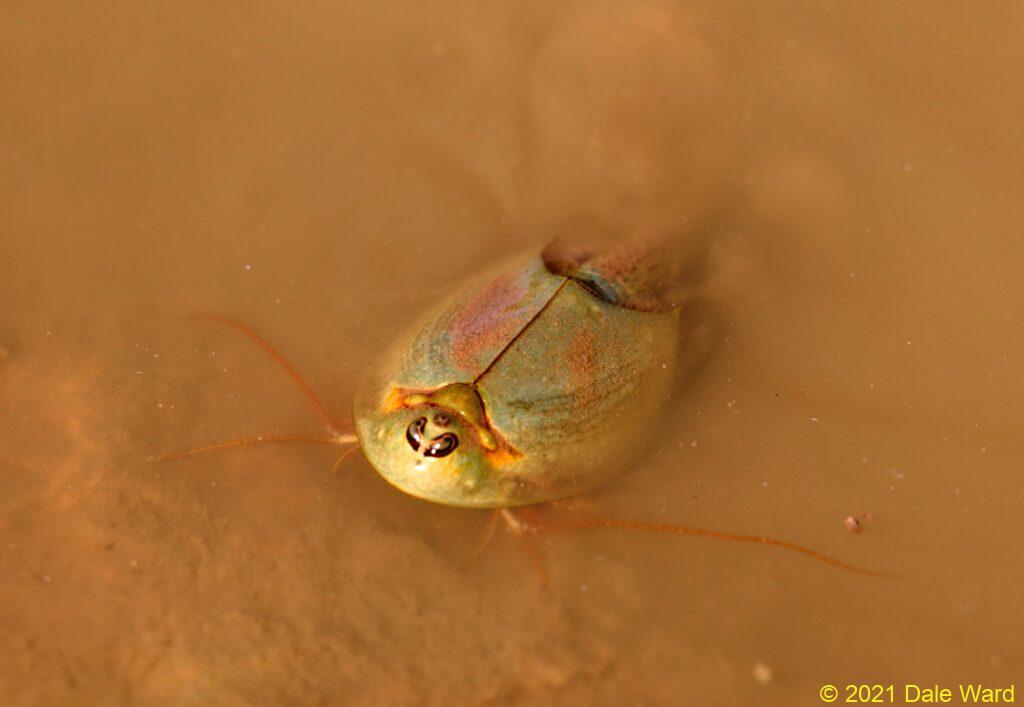 Tadpole Shrimp in shallow water. The long filaments near its head are its ‘first thoracopods’. You can see. They seem to act as both antennae, so the Triops can see where they are going, and as long “oars” to row the shrimp through shallow water.
Tadpole Shrimp in shallow water. The long filaments near its head are its ‘first thoracopods’. You can see. They seem to act as both antennae, so the Triops can see where they are going, and as long “oars” to row the shrimp through shallow water.
This was kind of a neat trip. On September 17, 2021, I drove out to the Sagebrush Deserts of Southwestern Colorado to take another look at one of my favorite critters, living in one of my favorite places.
Tadpole Shrimp (Triops longicaudatus), of course.
This particular location is a depression in the rocks that holds water. All around the depression is a sloping plain of slickrock, which acts as a catch basin for whatever rain falls. And since we had a good Summer monsoon this year, we had a lot of rain. The pool was perhaps fifty yards across, and perhaps 2 feet deep at its deepest.
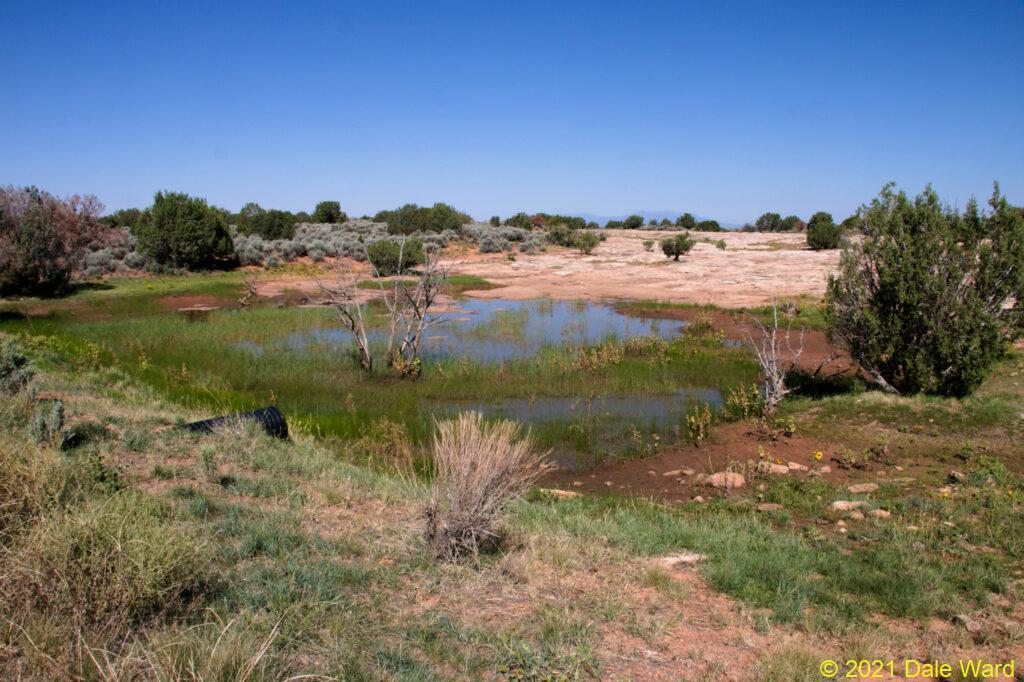 View of the ephemeral pool. This pool forms on the edge of broad expanse of slickrock. The slickrock acts as a catchment for rainwater, funneling it all to this location. Note how the sediment has collected here, and how different the vegetation is from the surrounding desert.
View of the ephemeral pool. This pool forms on the edge of broad expanse of slickrock. The slickrock acts as a catchment for rainwater, funneling it all to this location. Note how the sediment has collected here, and how different the vegetation is from the surrounding desert.
Even though a lot of the water had already evaporated, the soil surrounding the pool was still moist, and there was still plenty of water.
There is almost something interesting going on at these pools of water - they are magnets for life. When I got there, a Coyote resignedly trotted away, watching me over his shoulder.
The pool still had Tadpole Shrimp (Triops longicaudatus) in it, and a (relatively few) Spadefoot Toad (Spea multiplicata) tadpoles. Most of the tadpoles had already metamorphosed into Toads.
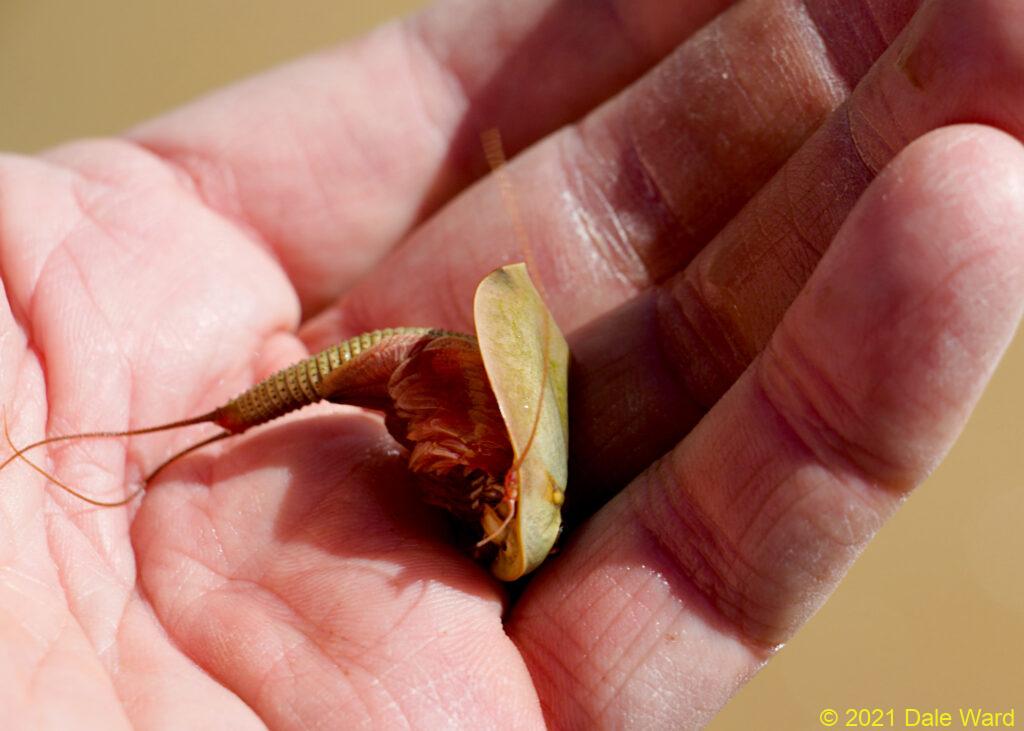 Tadpole Shrimp in my hand. This photo is from another day - I included it because you can get a look at the Tadpole Shrimp’s numerous thoracic appendages in this picture.
Tadpole Shrimp in my hand. This photo is from another day - I included it because you can get a look at the Tadpole Shrimp’s numerous thoracic appendages in this picture.
Even though the pool still had quite a bit of deep water left, the Triops seemed to be concentrated in the very shallow water at the edge of the pool. A lot of them had crawled almost out of the water, and were sitting with the backs in the air.
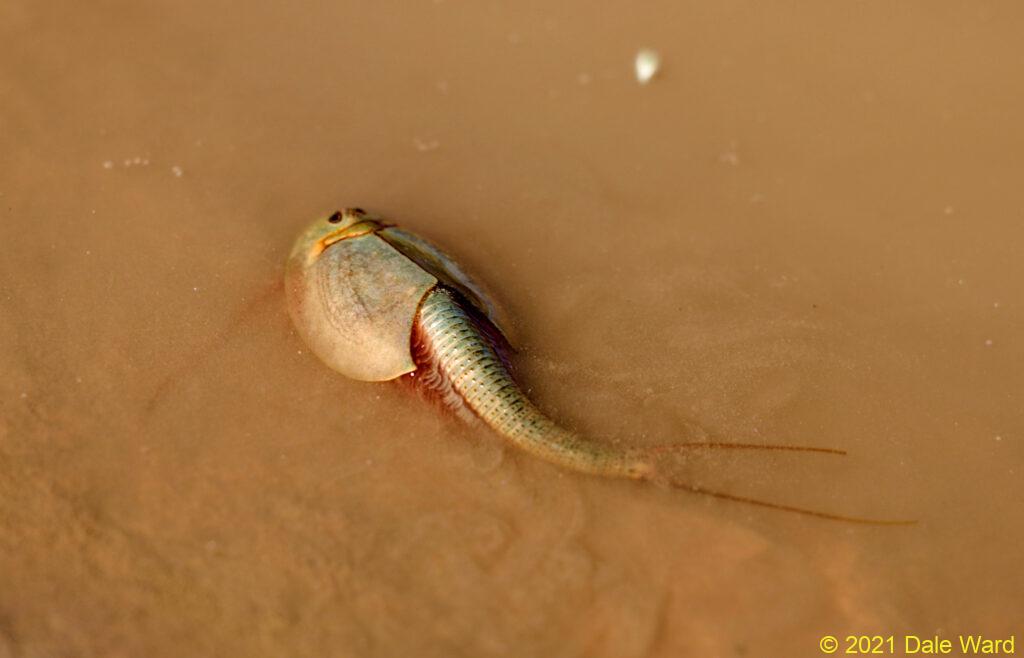 Tadopole shrimp in shallow water - the shrimp is more than half out of the water. You can see some if its abdominal appendages (the reddish objects along the shrimp’s abdomen), as well as some of the mud that it is stirring up with these legs.
Tadopole shrimp in shallow water - the shrimp is more than half out of the water. You can see some if its abdominal appendages (the reddish objects along the shrimp’s abdomen), as well as some of the mud that it is stirring up with these legs.
It was interesting to watch them in this shallow water. To move forward, they would use their long first pair of legs almost like oars, to row themselves over the silty shallows. They would sort of convulsively undulate their bodies in synchrony with their ‘rowing’ motion to move forward in fits and starts.
They were also running at least some of their smaller legs, the reddish ones that run along their abdomens, to stir the mud. They didn’t seem to be trying to move with these legs, they seemed to be trying to stir up the mud. I’m guessing that they were using these legs to filter feed.
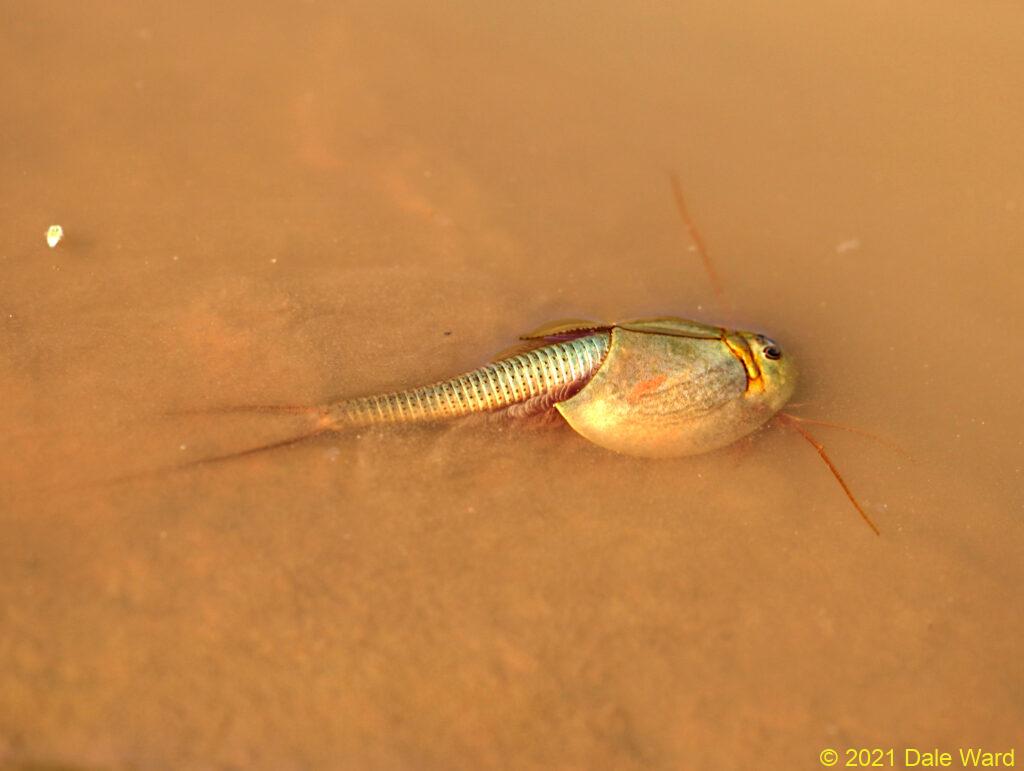 Side view of a Tadpole Shrimp in shallow water.
Side view of a Tadpole Shrimp in shallow water.
Even in slightly deeper water, the Triops would run their abdominal legs legs to stir up clouds of silt. They seemed to be using their long front legs and the flared edges of their carapace to hold themselves in place as their abdominal legs churned the mud. I think they do this churning to filter-feed.
I was able to get some nice photos of the Triops’ ‘three’ eyes while the Shrimp were in the extremely shallow water.
In the shot below, you can easily see the multiple facets of the two large, bean-shaped compound eyes, with the smaller ‘naupliar’ eye behind and between them. One should always keep one’s third-eye chakra open, I guess.
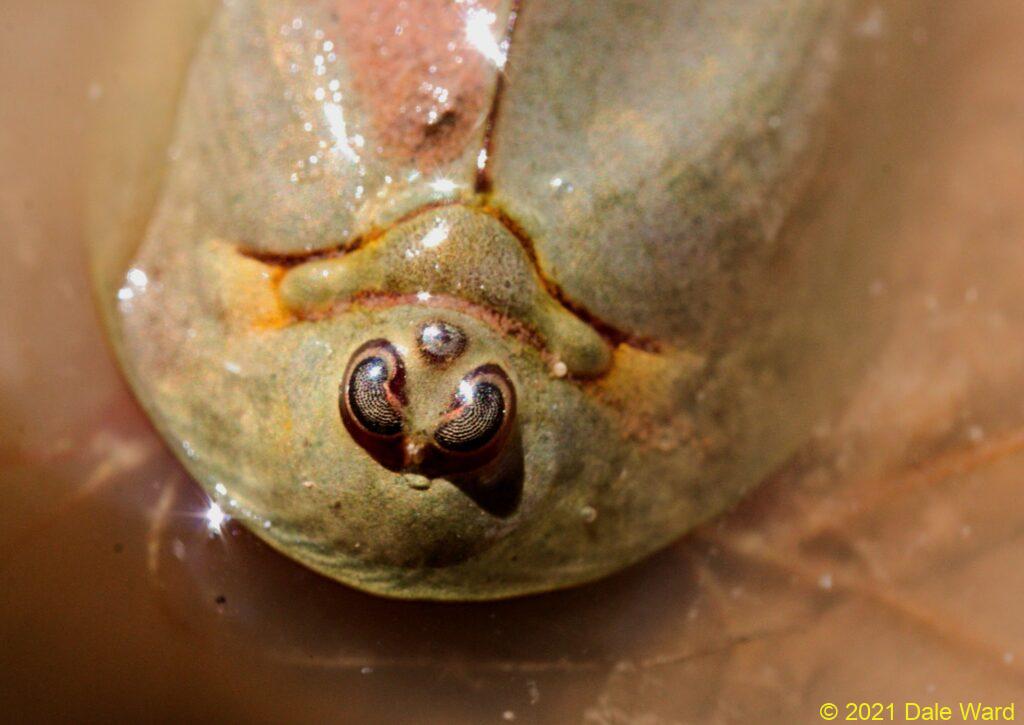 Closeup of a Tadpole Shrimp that has partially beached itself on the edge of the pool. You can see the individual facets of its two compound eyes (ringed by the reddish chitin), and the single-faceted nauplier eye between them. Also note the way that fine mud prartiles have settled on top of the shrimp’s carapace.
Closeup of a Tadpole Shrimp that has partially beached itself on the edge of the pool. You can see the individual facets of its two compound eyes (ringed by the reddish chitin), and the single-faceted nauplier eye between them. Also note the way that fine mud prartiles have settled on top of the shrimp’s carapace.
As I watched the Shrimp pushing through the shallow water, I was most interested to see the tracks that they were leaving in the mud. I’ve not noticed these before.
In the photo below, if you look where the tail of the Shrimp has dragged through the mud, you can see that it is leaving a furrow. In some instances, I’d also see where the edges of the Shrimp’s carapace had dragged, leaving a pair of parallel lines on either side of the ‘tail drag’.
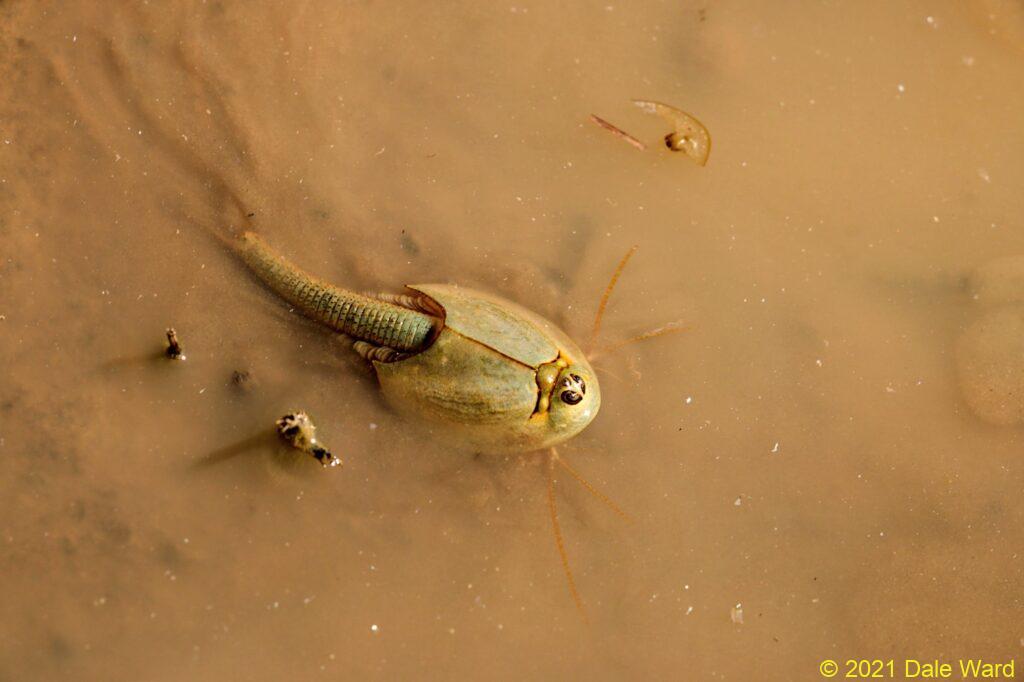 Tadpole Shrimp moving through the shallow mud at the edge of the pool. There is a single deep trough forming in the mud behind its tail. That trough is a combination of a drag-mark, from the tail being pulled through the mud, and a track, one that is dug by the shrimp’s numerous abdominal appendages.
Tadpole Shrimp moving through the shallow mud at the edge of the pool. There is a single deep trough forming in the mud behind its tail. That trough is a combination of a drag-mark, from the tail being pulled through the mud, and a track, one that is dug by the shrimp’s numerous abdominal appendages.
In many places, the Triops were digging pits in the mud. They were doing this by pushing their heads into the bottom of the pool and running their abdominal legs. That would throw a plume of mud and sediment out of the back of the pit, sort of like they were invertebrate dogs digging holes in the bottom of the pool.
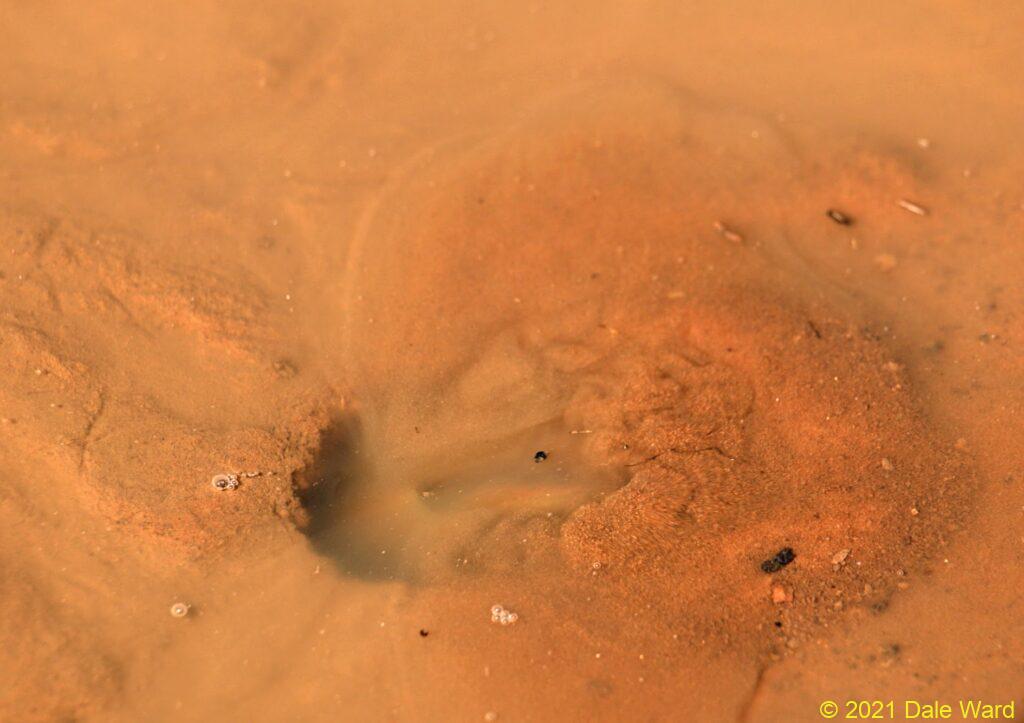 PIt being formed by Tadpole Shrimp. There is currently a Tadpole Shrimp in the pit - you can see the swirl of sediment being kicked out of the pit.
PIt being formed by Tadpole Shrimp. There is currently a Tadpole Shrimp in the pit - you can see the swirl of sediment being kicked out of the pit.
These pits were very numerous around the edges of the pool. As you can see in the photo below, the pits would often overlap. Some of the pits would presumably get filled in by the excavation of other, nearby, pits.
I think that the Shrimp were laying eggs in these pits, though I saw no evidence of actual egg-laying. Once a Shrimp had started a pit, other Shrimp would force themselves into it alongside the original shrimp. They would all dig, sending out plumes of mud into the water.
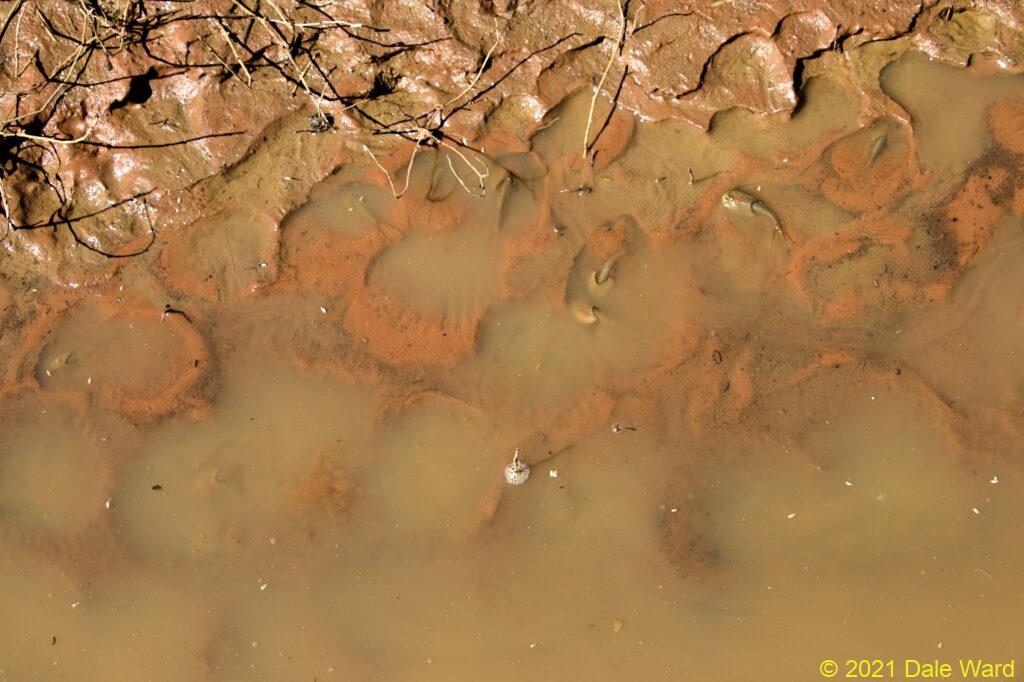 Overlapping pits at the edge of the pool. In the upper right quarter of the photo, in the water, you see that there are some Tadpole Shrimp still forming the pits.
Overlapping pits at the edge of the pool. In the upper right quarter of the photo, in the water, you see that there are some Tadpole Shrimp still forming the pits.
While I think that some of the Shrimp were laying eggs in the pits, I also suspect that at least some of the Shrimp were trying to filter the freshly-laid eggs of the other Shrimp out of the mud. Again, that’s just supposition on my part…but they all seemed awfully eager to get into these pits.
Here’s a shot of the same pits, with my hand for scale. You can see that the pits are overlapping to such a degree that they form a scalloping patter in the mud. Also note that you can see old pits, where the water has receded.
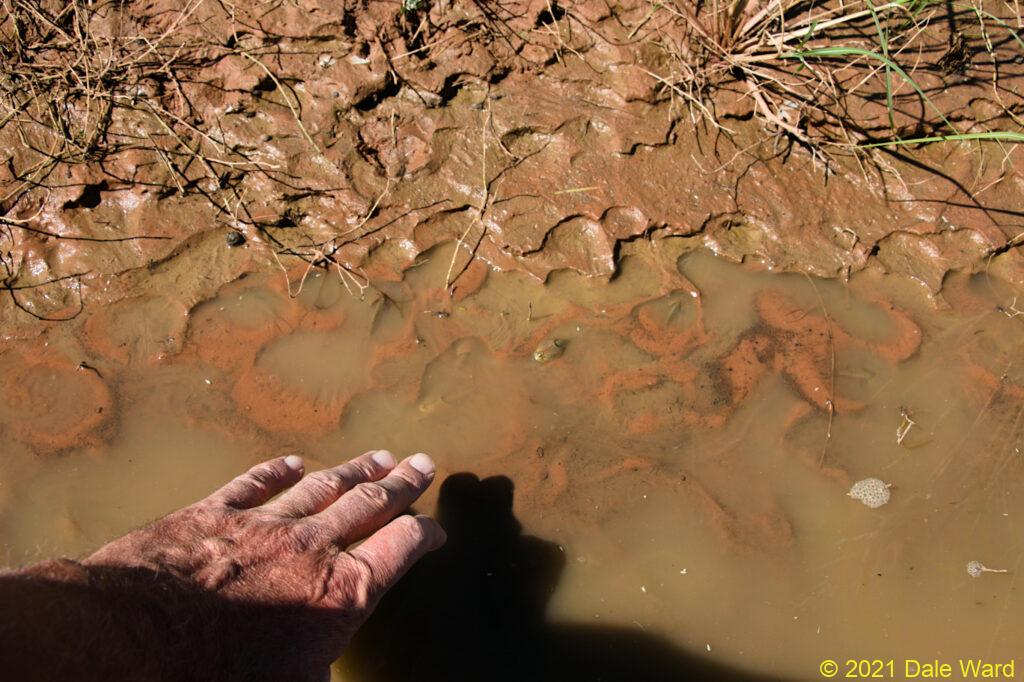 Overlapping Tadpole Shrimp pits at the edge of the pool, with my hand for scale.
Overlapping Tadpole Shrimp pits at the edge of the pool, with my hand for scale.
Below are a couple of shots of the muddy bank above the waterline of the pool. You can clearly see the remains of the pits, and if you look closely, you can also see series of parallel lines in the mud. I’m thinking these lines are tail and carapace drags.
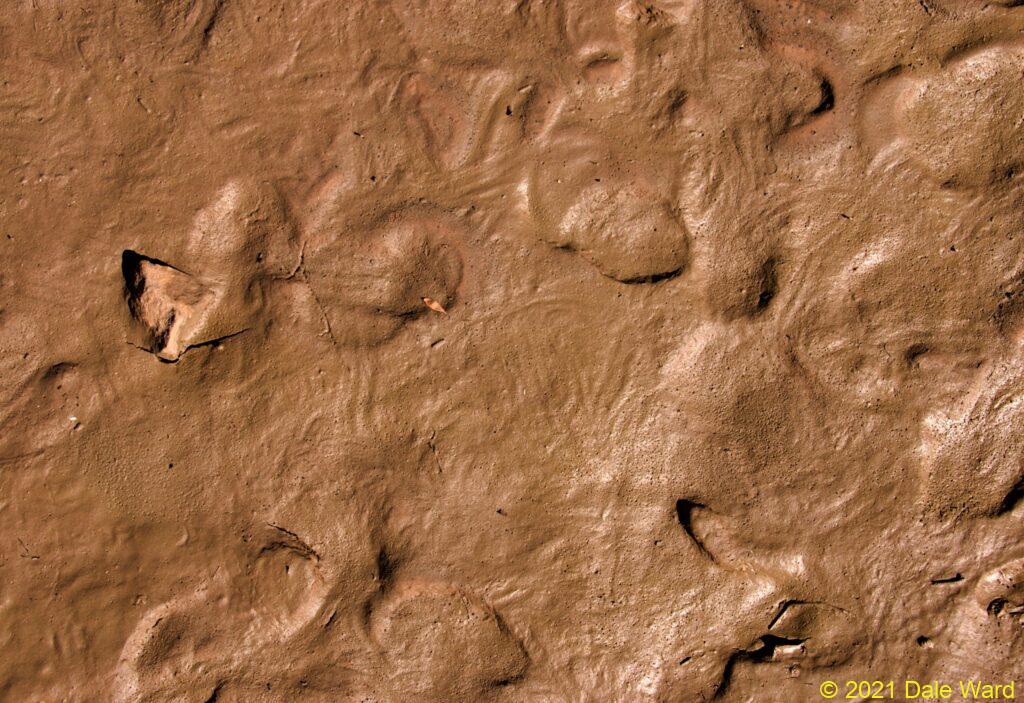 Tadpole Shrimp (Triops longicaudatus) tracks in the drying mud at the edge of the pool. The larger divots are pits that the shrimp have dug. The light grooves on the mud surface are the edges of shrimp carapaces and abdominal drags in the mud.
Tadpole Shrimp (Triops longicaudatus) tracks in the drying mud at the edge of the pool. The larger divots are pits that the shrimp have dug. The light grooves on the mud surface are the edges of shrimp carapaces and abdominal drags in the mud.
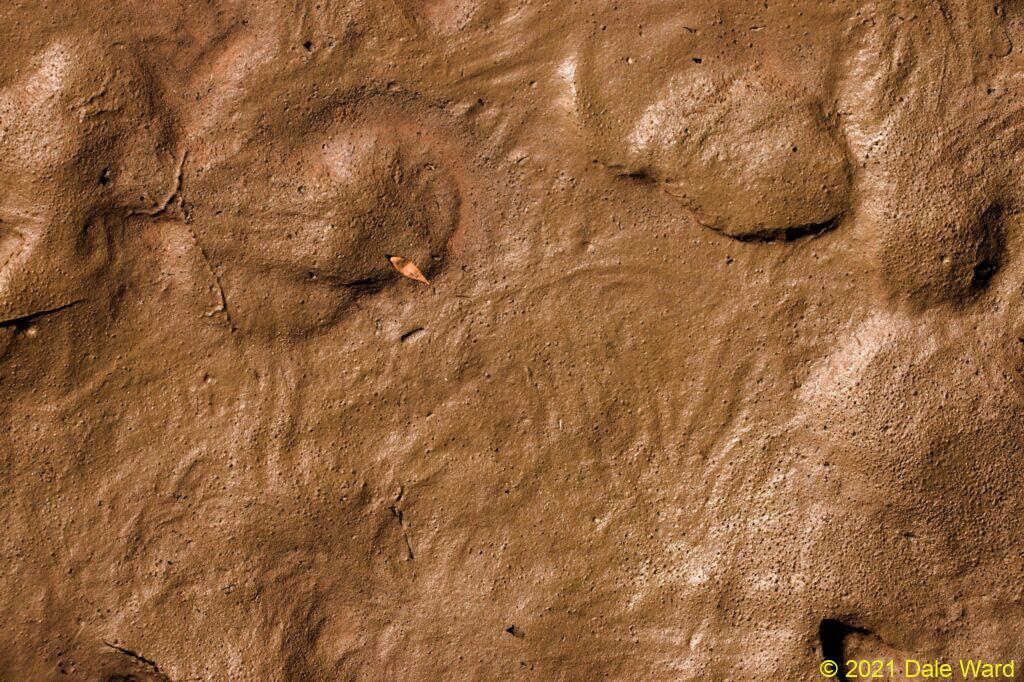 Closer view of the Tadpole Shrimp traces in the drying mud. You can clear see the row of partially overlapping pits near the top of the photos, and the lighter drag marks in the mud in the rest of the photo.
Closer view of the Tadpole Shrimp traces in the drying mud. You can clear see the row of partially overlapping pits near the top of the photos, and the lighter drag marks in the mud in the rest of the photo.
I thought that was really cool. But what really blew my mind…I often see patterns similar to these impressed into the surface of slickrock. Is it possible that some of those slick-rock patterns are actually fossilized Triops tracks?
I poked around a little bit on the web and came up with a marvelous paper by Drs. Knecht and Benner. They studied Pleistocene fossils from the Connecticut River Valley that looked very similar to the tracks I’d found. And they did lab work with captive Triops showing that their fossils looked a lot like the tracks left by their captive Triops. They also sent me another paper, one in which Spanish scientists had documented fossilized Triops tracks from the Permian - ones which were formed in playa conditions, more closely resembling the conditions under which I was seeing the tracks being created.
So…yes, these Triops tracks fossilize, and it is possible to find these ancient fossilized tracks. How many of the patterns in the sandstone are fossilized Triops? I’m guessing very few, and that most of the Triops-like patterns in the sandstone I see just look like Triops, but were actually formed by some other, purely physical, process.
But you can bet that I’ll be keeping a closer eye out when I’m hiking across slickrock.
I also made a video of this day’s adventures. You can see it here:
Update:
So roughly two months later I revisited this pool. Some of the soil was still damp, but most of it was cracked mud, or dust.
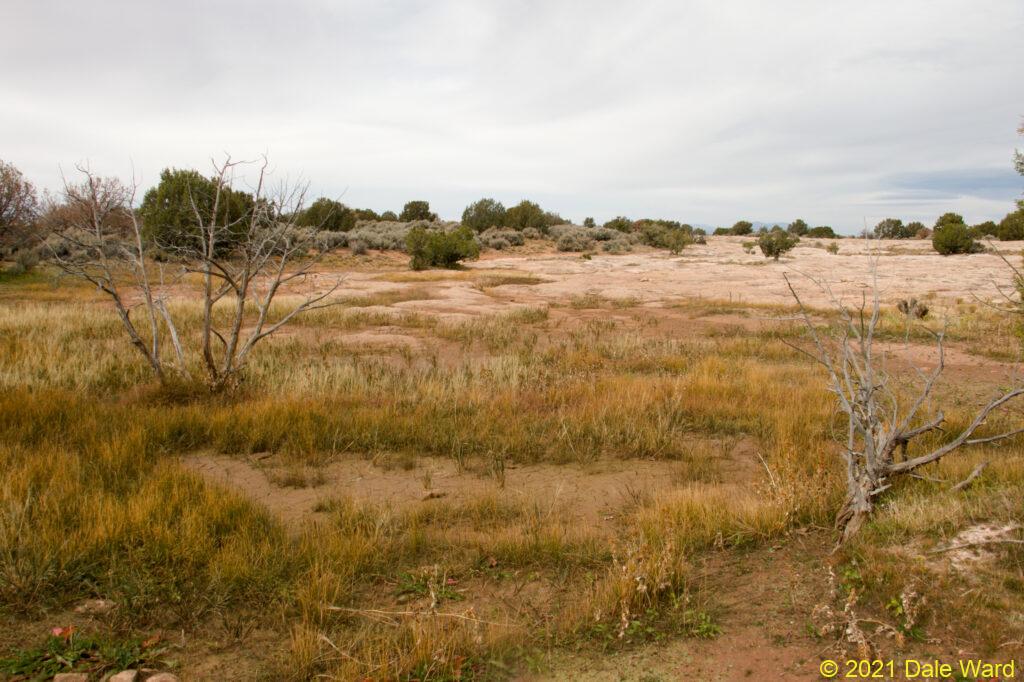 Same location, two months later. Most of the erstwhile pool is dust or cracked mud. The previously gren vegetation is drying out.
Same location, two months later. Most of the erstwhile pool is dust or cracked mud. The previously gren vegetation is drying out.
I saw lots of canine tracks (probably Coyote) and bird tracks (waterfowl, wading birds, and Ravens). I could just barely see remnants of the Triops egg pits.
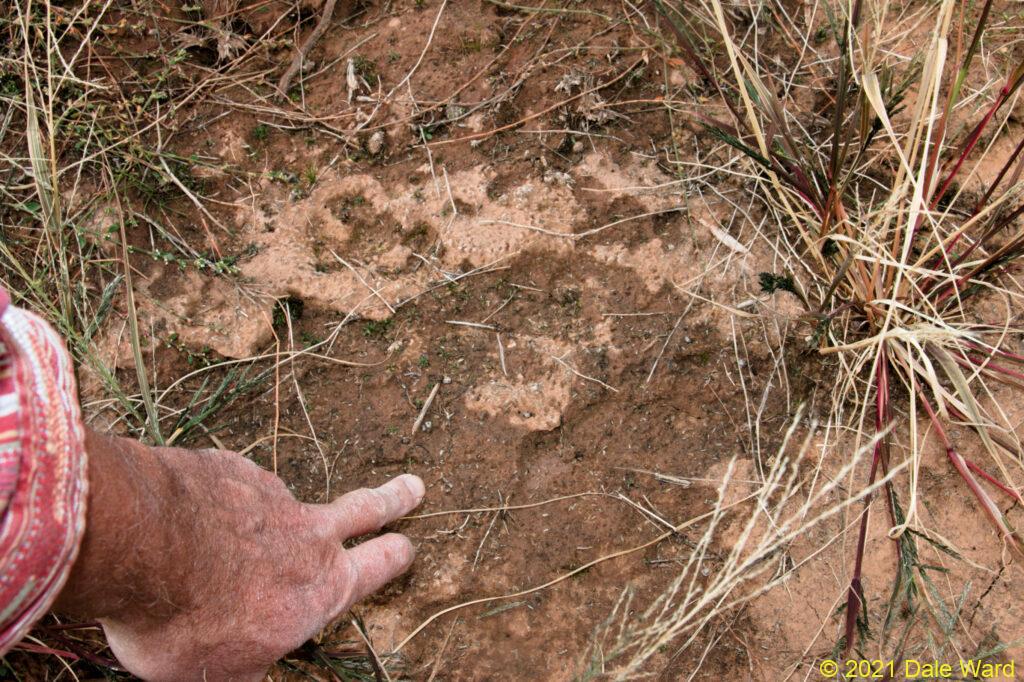 Remains of the Triops egg pits, barely visible as depressions in the damp soil.
Remains of the Triops egg pits, barely visible as depressions in the damp soil.
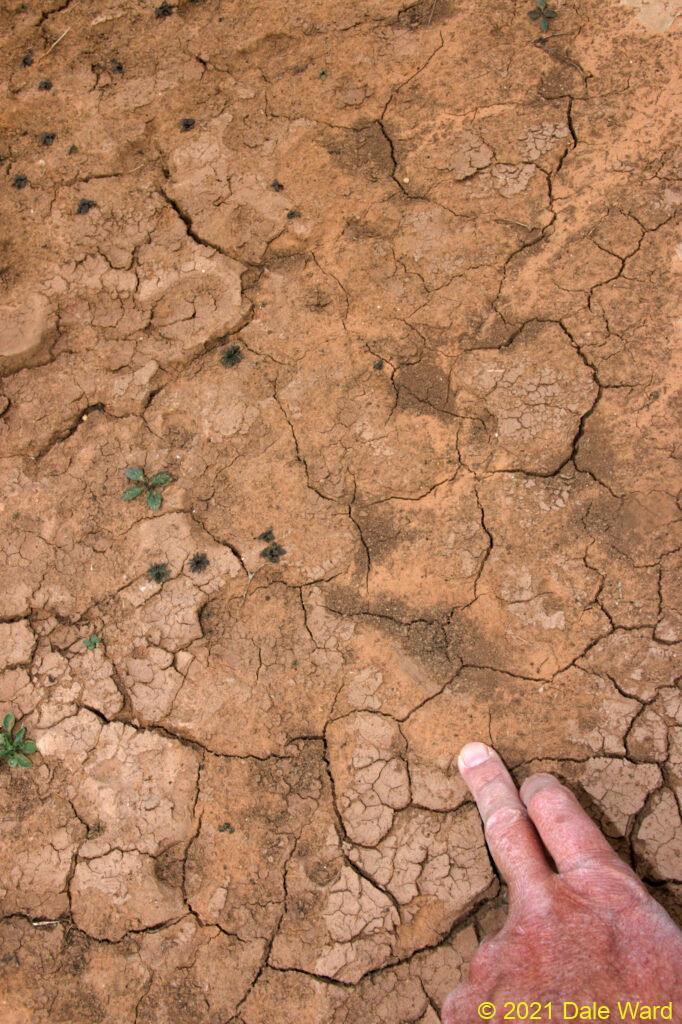 Barely visible Triops egg pits in the dust.
Barely visible Triops egg pits in the dust.
Sources:
Richard J. Knecht, Jacob S. Benner, D. Christopher Rogers , John C. Ridge. 2009. Surculichnus bifurcauda n. igen., n. isp., a trace fossil from Late Pleistocene glaciolacustrine varves of the Connecticut River Valley, USA, attributed to notostracan crustaceans based on neoichnological experimentation. Palaeogeography, Palaeoclimatology, Palaeoecology 272 (2009) 232–239.
G. Gand, J. Garric, J. Schneider, H. Walter, J. Lapeyrie, C. Martin, A. Thiery. 2008. Notostraca trackways in Permian playa environments of the Lodève basin (France). Journal of Iberian Geology 34 (1) 2008: 73-108.